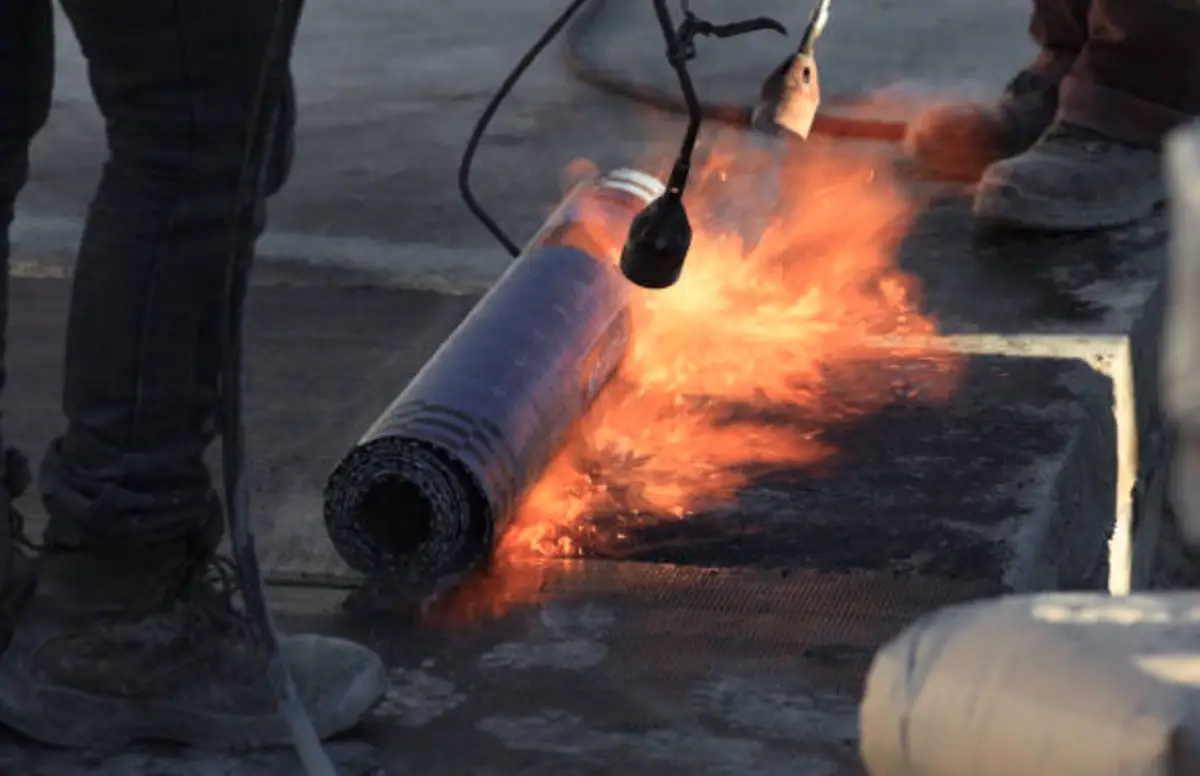Last Updated on: 12th August 2023, 05:59 pm
Did you know that the torch down roofing method has been a popular choice for flat and low-slope roofs since the 1970s? In this article, we´ll delve deeper into torch down roofing, examining its installation process, advantages, and disadvantages. And, we will explore alternatives to consider when selecting the ideal roofing system for your home or commercial building.
What is Torch down roofing?
Torch down roofing, also referred to as modified bitumen roofing, is a type of roofing material specifically designed for flat and low-slope roofs. It consists of multiple layers of modified bitumen (a blend of asphalt combined with rubber or plastic polymers) that are applied to the roof surface using a torch. The heat from the torch melts the bitumen, enabling it to adhere to the roofing substrate and create a waterproof and durable abrrier. This results in a long-lasting and resilient roofing system that can withstand various weather conditions and protect your home or building.
What is the installation process of torch down roofing?
Safety precautions
Before diving into the installation process, it´s paramount to emphasize that modified bitumen roofing involves the use of an open flame. As a result, safety precautions must be taken, and it´s strongly recommended to hire an experienced and licensed roofing contractor to ensure proper installation and minimize the risk of accidents.
Installation steps
The installation processof modified bitumen roofing typically involves the followi ng steps:
- Preparation: Remove any existingr oofing material, clean the roof surface, and install a layer of insulation or a base sheet if required.
- Base layer: Roll out the base layer of modified bitumen, aligning it correctly and securing it to the roof surface with nails or an adhesive.
- Torch application: Using a propane torch, heat the bottom side of the modified bitumen membrane as it´s unroled onto the roof surface. The heat melts the bitumen, allowing it to bond with the base layer or roof surface.
- Seams: Overlap each subsequent layer of modified bitumen to create a waterproof seal, ensuring all seams are properly torched and sealed.
- Flashing: Install flashing around roof penetrations (such as vents, chimneys, or skylights) and at the roof edges to provide additional waterproofing and protection.
- Final inspection: Once the instalation is complete, inspect the roof surface for any gaps or flaws, and make any necessary repairs.
How does torch down roofing compare to alternatives?
It´s essential to compare modified bitumen roofing to alternative roofing systems to determine if it´s the right choice for your project. Some popular alternatives to heat-applied roofing include:
EPDM rubber roofing
EPDM (ethylene propylene diene monomer) rubber roofing is a single-ply membrane made from a durable synthetic rubber material. It offers excellent waterproofing and UV resistance, with a longer lifespan than heat-applied roofing. EPDM roofing can be installed using adhesives, mechanical fasteners, or ballasted with stones, making it a flame-free installation option.However, it may be less resistant to punctures and tears compared to heat-applied roofing.
Trending Now:
PVC and TPO roofing
PVC (polyvinyl chloride) and TPO (thermoplastic olefin) roofing are single-ply membranes made from durable plastic materials. Both options provide excellent waterproofing, UV resistance, and energy efficiency, as they can reflect sunlight and help reduce cooling costs. PVC and TPO roofing systems are typically heat-welded or mechanically fastened during installation, eliminating the need for an open flame. However, they can be more expensive than torch down roofing and may not be as resistant to punctures adn tears.
Built-up roofing (BUR)
Built-up roofing (BUR) systems consist of multiple layers of tar and gravel, creating a thick and durable roof surface. BUR has been used for many years and offers excellent waterproofing and fire resistance. However, BUR can be heavier than modified bitumen roofing and may require additional structural support. The installation process can be more time-consumin gand may produce unpleasant odors during the application.
What are the advantages and disadvantages of modified bitumen roofing?
Advantages
- Durability: Torch down roofing provides a long-lasting and resilient roofing system that can withstandvarious weather conditions, including heavy rain, snow, and hail.
- Waterproofing: The seamless application and multiple layers of modified bitumen create a waterproof barrier, reducing the risk of leaks and water damage.
- UV resistance: Torch down roofing is resistant to UV rays, which can help reduce coo ling costs and prolong the life of the roof.
- Ease of installation: Although it involves using an open flame, the installation process is relatively straightforward for experienced and licensed roofing contractors.
Disadvantages
- Safety concerns: The useof an open flame during installation can pose a safety risk and requires proper safety precautions and experienced roofing professionals.
- Limited slope compatibility: Torch down roofing is bestsuited for flat and low-slope roofs, making it less versatile compared to other roofing systems.
- Environmental concerns: The manufacturing process of modified bitumen and the use of a propane torch during installation can contribute to air pollution and increased carbon emissions.
Before deciding on heat-applied roofing for your project, it´s es sential to weigh the advantages and disadvantages and compare it to alternative roofing systems. Consulting with a licensed roofing contractor can provide valuable guidance in making the best decision for your home or comercial building.
Conclusion
Torch down roofing has been a popular choice for flat and low-slope roofs since the 1970s, thanks to its durability, waterproofing capabilities, and UV resistance. While it does have some disadvantages, such as safety concerns and limited slope compatibility, it remains a reliable option for many roofing projects. Always consult with a profesional roofing contractor to determine if modified bitumen roofing is the right choice for your specific needs and to ensure proper installation and safety precautions are followed.





